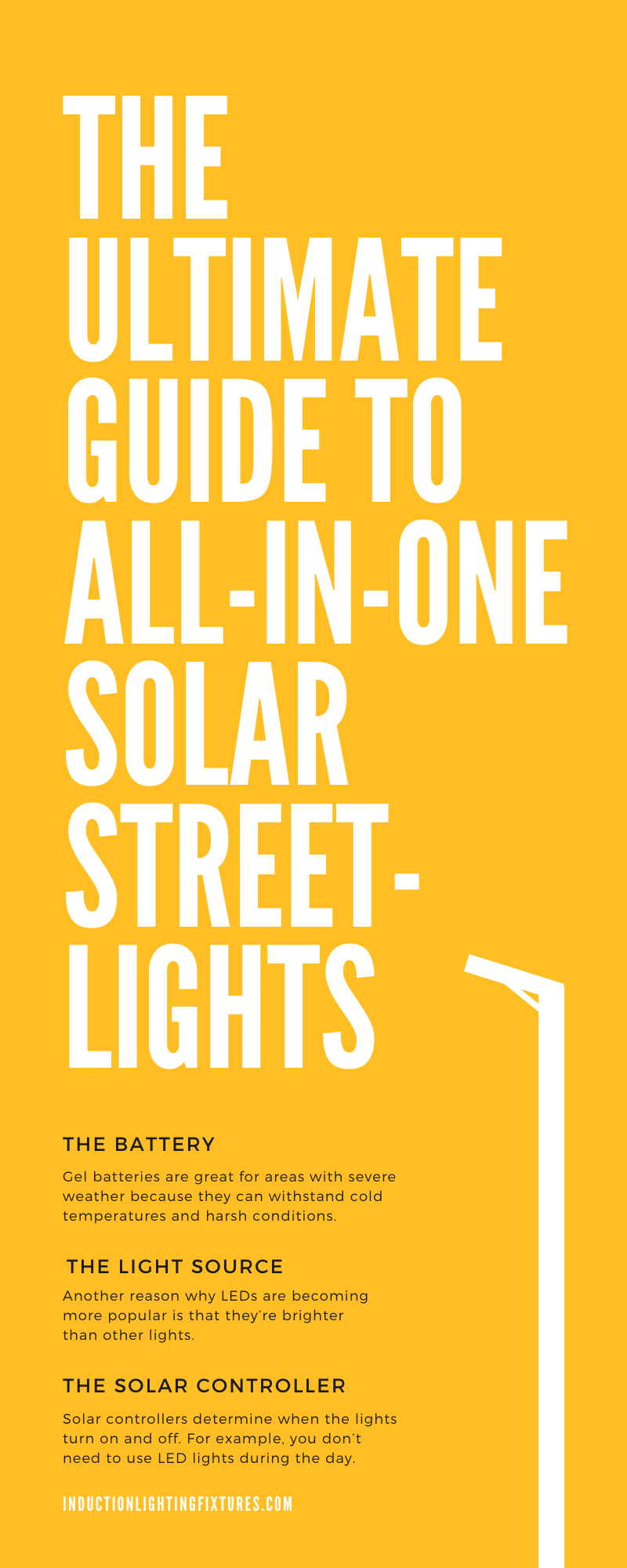The Ultimate Guide to All-in-One Solar Streetlights
Sustainability is on the mind of every business owner these days. Company leaders want to do everything they can to help the environment and appease customers by doing their part. These professionals cut back on waste, use more environmentally friendly materials, and implement energy-efficient lighting options. Coincidentally, city municipalities are also following these trends. This article will focus on one sustainable change that cities make: using all-in-one solar streetlights. After reading this, town officials will rush to make the change that so many business owners already have.
What Are All-in-One Solar Streetlights?
All-in-one solar streetlights are integrated solar lights with four main components. The main parts of an all-in-one solar streetlight are the solar panel, battery, light source, and solar controller. It’s vital to go through each part to understand how these mechanisms work.
The Solar Panel
Most all-in-one solar streetlights use monocrystalline solar panels. Monocrystalline panels have a much higher conversion rate than other solar panels on the market. What’s more, these items hold up better in bad weather and rough conditions. Essentially, monocrystalline solar panels collect energy from the sun during the day and store it to charge the battery at night. This system makes monocrystalline solar panels incredibly energy-efficient.
The Battery
Engineers are always looking for long-lasting batteries for streetlights. After all, when one of them goes out, it creates darkness and potential danger on the roadways. There are two main types of batteries often used in streetlights: gel batteries and lithium-ion batteries. However, city leaders should stay away from lithium acid batteries. Gel batteries are great for areas with severe weather because they can withstand cold temperatures and harsh conditions.
Furthermore, lithium-ion batteries last almost six times longer than lithium acid batteries. Lithium-ion batteries also require less maintenance. Officials must make the right choice regarding battery usage for streetlights since the wrong battery can cause major problems in the community.
The Light Source
Most people would agree that LEDs are taking over the lighting industry. This statement even rings true when discussing all-in-one solar streetlights. LEDs last much longer than translucent lightbulbs because they output less energy. Also, this makes them better for the environment.
Another reason why LEDs are becoming more popular is that they’re brighter than other lights. City leaders may be interested to know that fact because the brighter the light, the safer people will be at night.
The Solar Controller
The next part of all-in-one solar streetlights is the solar controller. This is where the fun stuff comes in. Being that this is the ultimate guide to all-in-one solar streetlights, one would expect a note on automation. Well, we’re about to extend upon that point. Solar controllers determine when the lights turn on and off. For example, you don’t need to use LED lights during the day.\
The lights will turn off until they’re needed. Manufacturers can also set specific times for the lights to turn on and off. Both of these features save energy because the light doesn’t run when it’s not needed. The solar controller can also set up a motion sensor. Essentially, the LED light will turn on when someone is near and turn off once the person leaves. Solar controllers helped usher in a more advanced technological era for the lighting industry.
Now that we’ve discussed the four main parts of all-in-one solar streetlights, we can examine why cities and campuses across the country should install these instead of traditional streetlights.
Reasons To Use All-in-One Solar Streetlights
We discussed the four components of all-in-one solar streetlights above. Inadvertently, we touched on the benefits of using them, too. Yet, the topic deserves more attention. So the rest of the ultimate guide to all-in-one solar streetlights will analyze the benefits of using them.
Easy To Install
Here at Induction Lighting Fixtures, we’re proud to offer integrated solar lights that are easy to install. For example, the LAR20 20W All-in-One Solar LED Streetlight/Solar Powered Area Light is easy to install. All people need are a few screws and the right tools to put one of these on. What’s more, they’re easy to discharge since they’re so simple to install.
Less Energy Consumption
All-in-one solar streetlights consume about 60 percent less energy than their halide counterparts. Halide lights usually use 60-80 lumens per watt. Conversely, all-in-one solar LED streetlights use 200 lumens per watt. This information means that all-in-one solar LED streetlights can absorb more energy/sunlight during the day. This process makes them brighter at night. Since LEDs use less energy, they inadvertently allow city leaders to save money. Their automation services allow the lights to turn off when no one uses the energy. So they don’t cost as much as streetlights that must stay on at all times.
Can Withstand Rough Weather Conditions
We designed our integrated solar lights better than other traditional streetlights. These streetlights are more compact, with solar panels inside them. For this reason, they’re sturdier than other lights with a separate solar panel.
Hopefully, city officials and owners of large arenas have learned all they need to know about all-in-one solar streetlights. This piece has proven that these items are worth the investment. For starters, they burn brighter than other traditional streetlights. Brightness creates safer environments for pedestrians walking at night. Furthermore, integrated solar lights are much more energy-efficient. These lights consume far less energy than competitors on the market. This notion will help make towns/cities greener; thus, appealing to public concern.
All of us must make sustainability a top priority to keep the planet safe. There are simple things that municipalities can do to accomplish this goal. For starters, they can start a more comprehensive recycling program that encourages people to take on the practice. What’s more, this article has demonstrated the environmental benefits of using all-in-one streetlights. The change can lead to a decrease in energy consumption while simultaneously keeping people safer in dark areas. City officials who found any of the above information helpful should check out our selection of all-in-one streetlights today. We pride ourselves on being a leader in the industry, and we aim to help cities become more sustainable.

Recent Posts
-
Spotlight - The IL-SPG54 Smart Solar Walkway Light: Where Performance Meets Simplicity
Introducing the IL-SPG54 Smart Solar Walkway Light: Where Performance Meets Simplicity When it comes …Jun 16th 2025 -
Corn Bulb Sale - While supplies last!
⚡ Limited Time Sale – BLE Series Corn Lamps Starting at $24.99! Stock up now while supplies la …Jun 11th 2025 -
Dark Sky Lighting in Breckenridge Colorado. Can I retain my existing fixture and still comply with the new Rules?
Breckenridge Colorado Dark Sky lighting has been a focus of ours for the last year. All resid …May 2nd 2025






